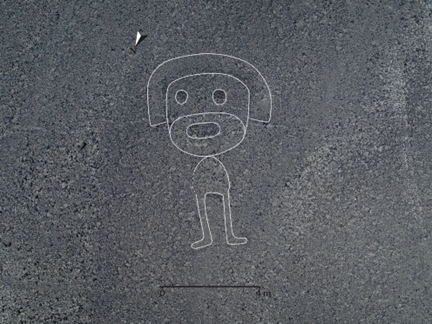Researchers from Japan and Peru have uncovered more mysterious designs in and around Peru’s Nazca plain that archaeologists hope will shed more light on the ancient artworks that have puzzled scientists for decades.

Peru’s iconic Nazca lines are massive drawings in the ground known as geoglyphs. Some of the designs are so large that they can only be seen from the air, and yet, humans 2,000 years ago were able to etch the enigmatic figures into the dirt. Some of the Nazca lines are still visible to the eye to this day and are a popular tourist destination in the country.

On Dec. 9, scientists from Yamagata University, in partnership with Jorge Olano, head archaeologist for the Nazca lines research program, announced that they found 168 new designs at the UNESCO World Heritage site on Peru’s southern Pacific coast.
The recently discovered etchings depict stylized humans, camelids (e.g. llamas and alpacas), birds, killer whales, felines and snakes, according to a press release from Yamagata University. The figures are believed to date back to between 100 BCE and 300 CE — a span of time that ranges from the rise of Julius Caesar to the arrival of Christianity in the Roman Empire under Constantine I.

Get breaking National news
“These geoglyphs were created by removing black stones from the surface of the earth to expose a white sandy surface below,” the press release reads.
The researchers used high-resolution aerial photography and drones to identify the new Nazca lines, which had never been seen before by modern eyes. The survey began on June 2019 and took nearly two years to complete.
The newly discovered Nazca lines are, on average, between two and six metres in length, according to Olano, and can be seen from the ground. Meanwhile, some of the largest Nazca lines depicting stylized geometric patterns are several kilometres long.
Archaeologists still do not know the purpose of the Nazca lines, though UNESCO writes that they are “believed to have had ritual astronomical functions.”
The figures, iconic vestiges of Peru’s rich history, are about a three-hour drive from the capital Lima.
Researchers had already discovered 190 figures in the area since 2004 — bringing the grand total of known Nazca lines to 358. But the vastness of the terrain they cover has complicated efforts to study and conserve the heritage site.
Yamagata University said the research will be used in artificial intelligence-based surveys to help inform the lines’ preservation.
Studies from the university in collaboration with Peru’s government have helped delineate and protect the area, which is facing threats from urban and economic developments.
“Some geoglyphs are in danger of being destroyed due to the recent expansion of mining-related workshops in the archaeological park,” said Masato Sakai, a professor from Yamagata University who co-led the study.
— With files from Reuters







Comments